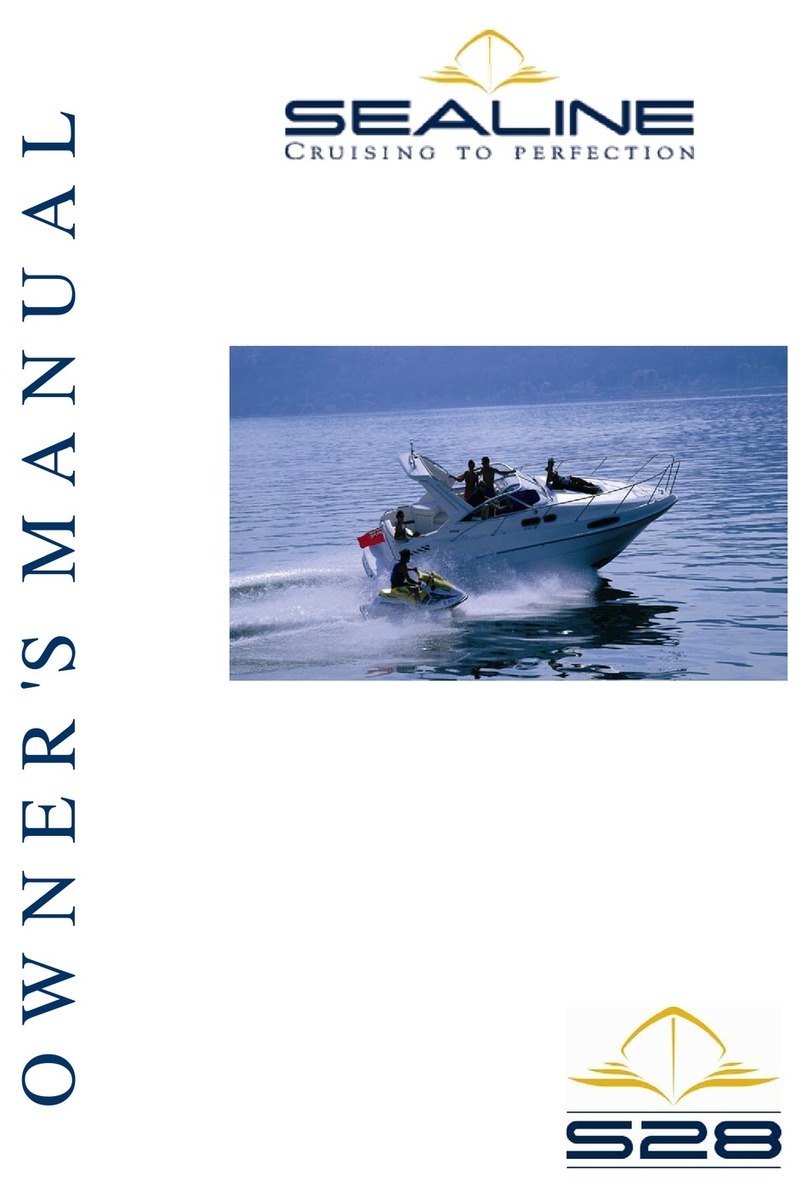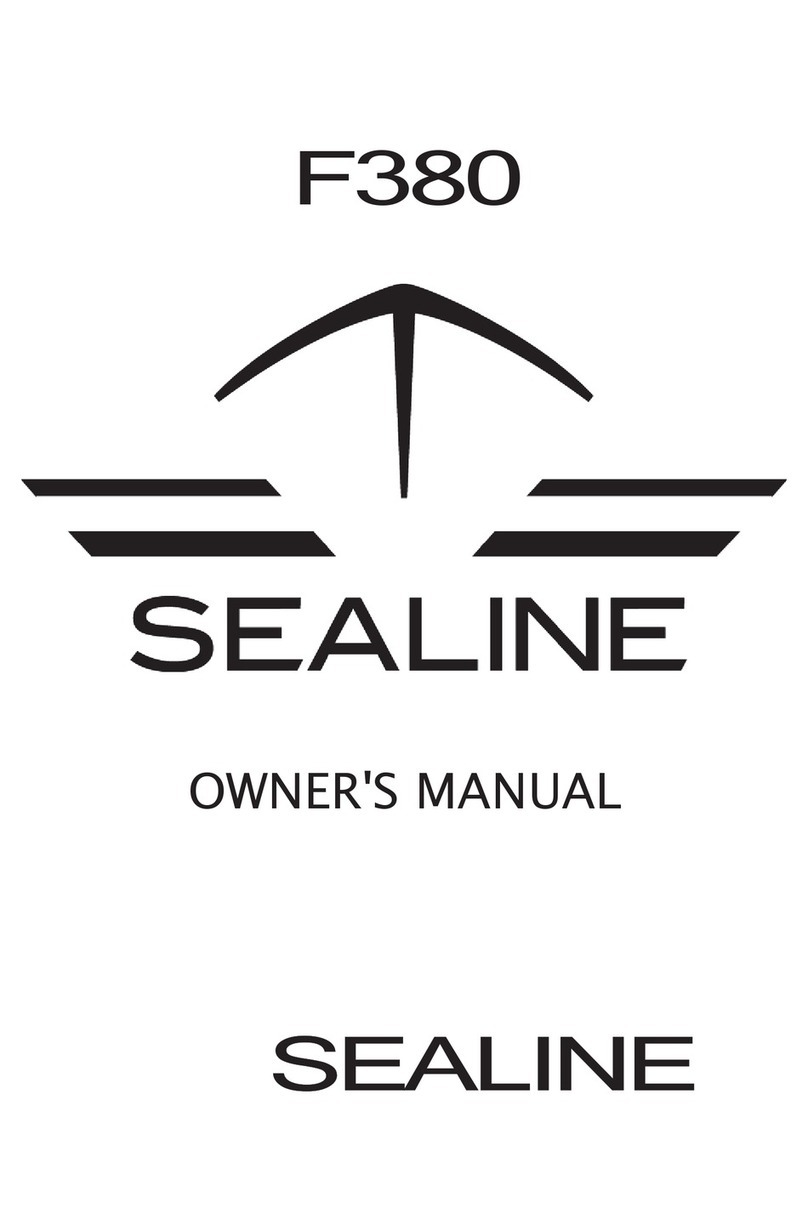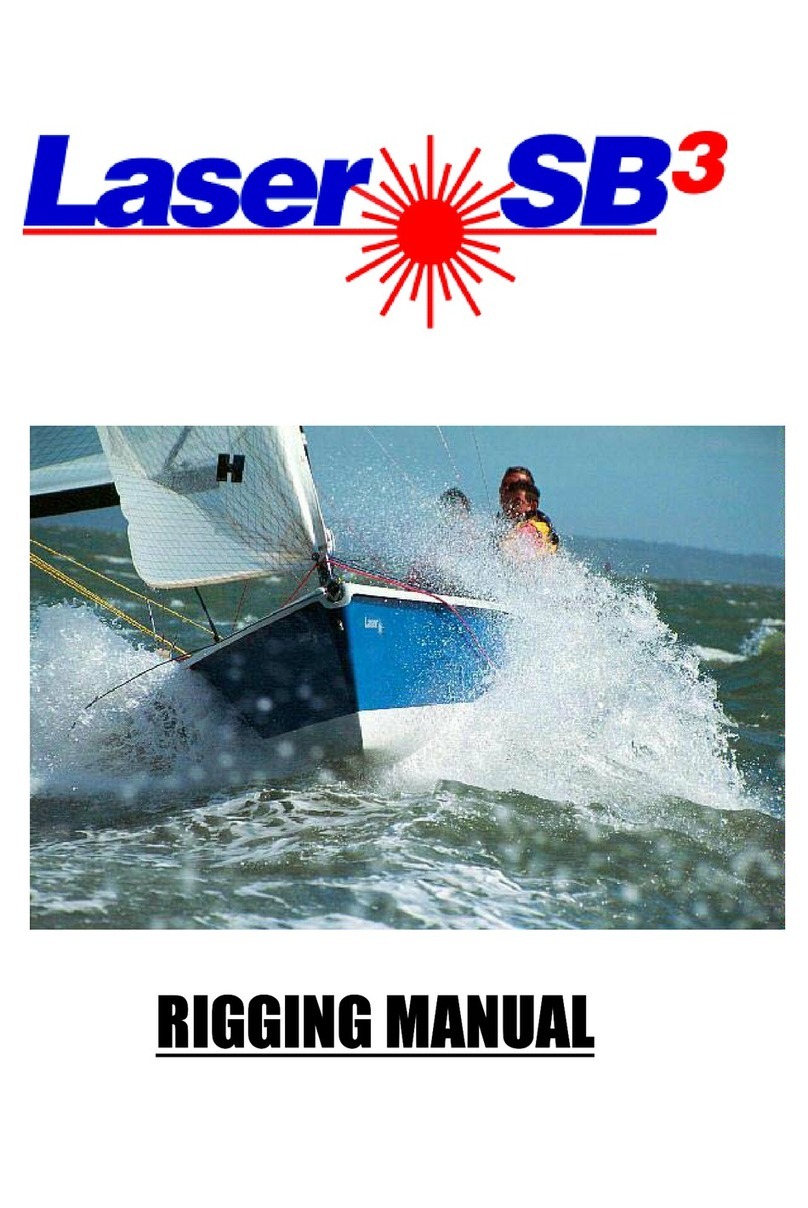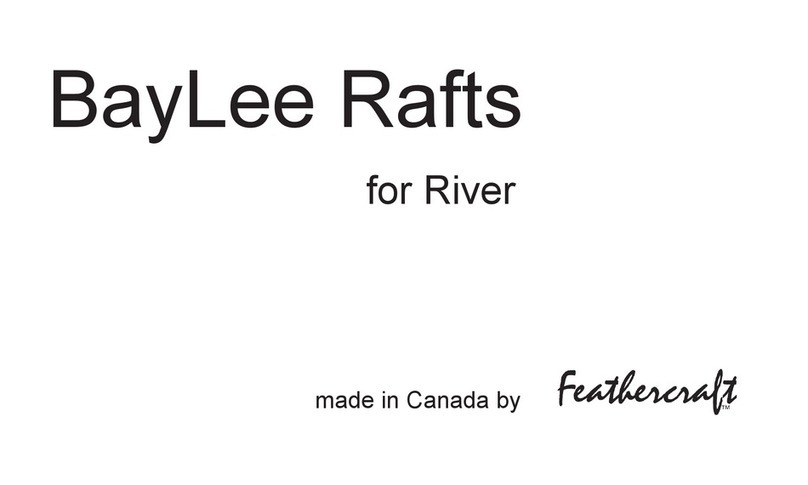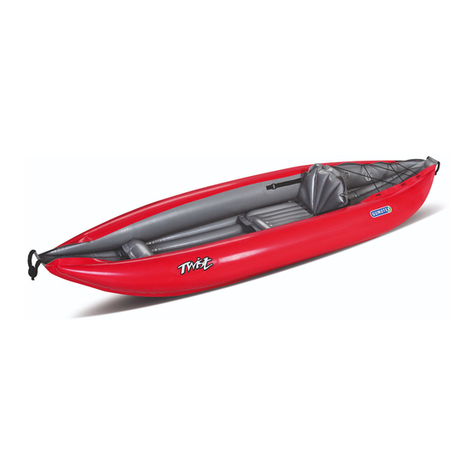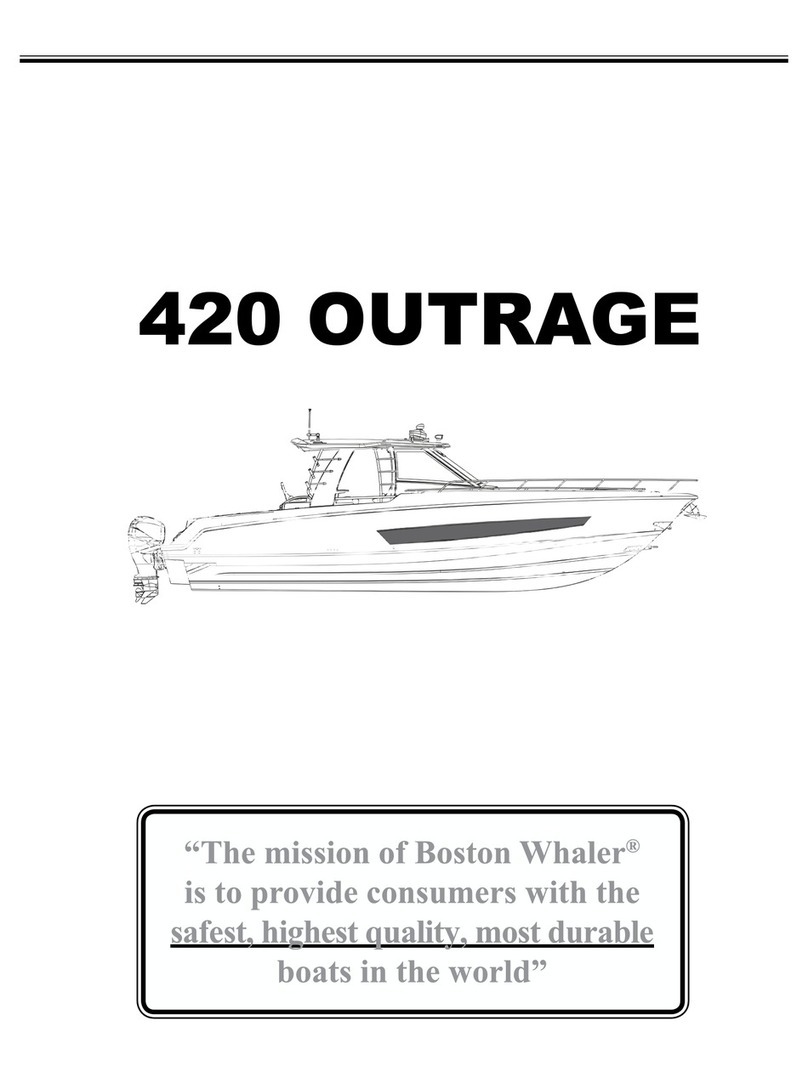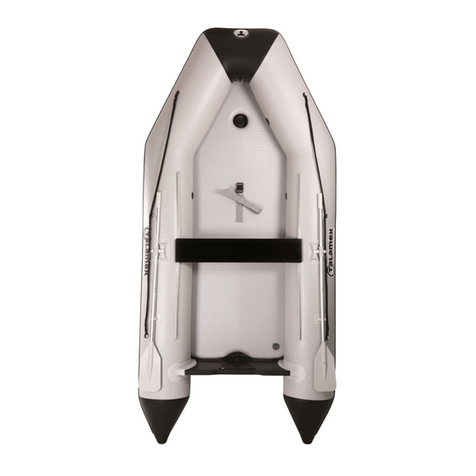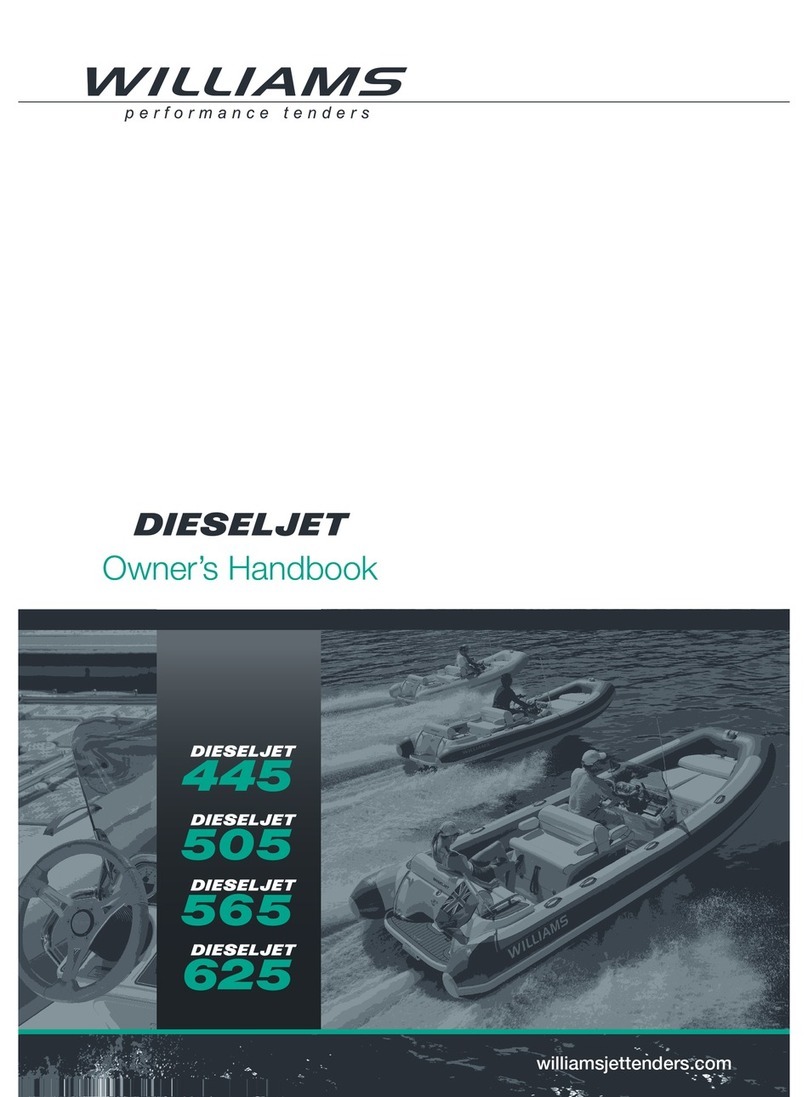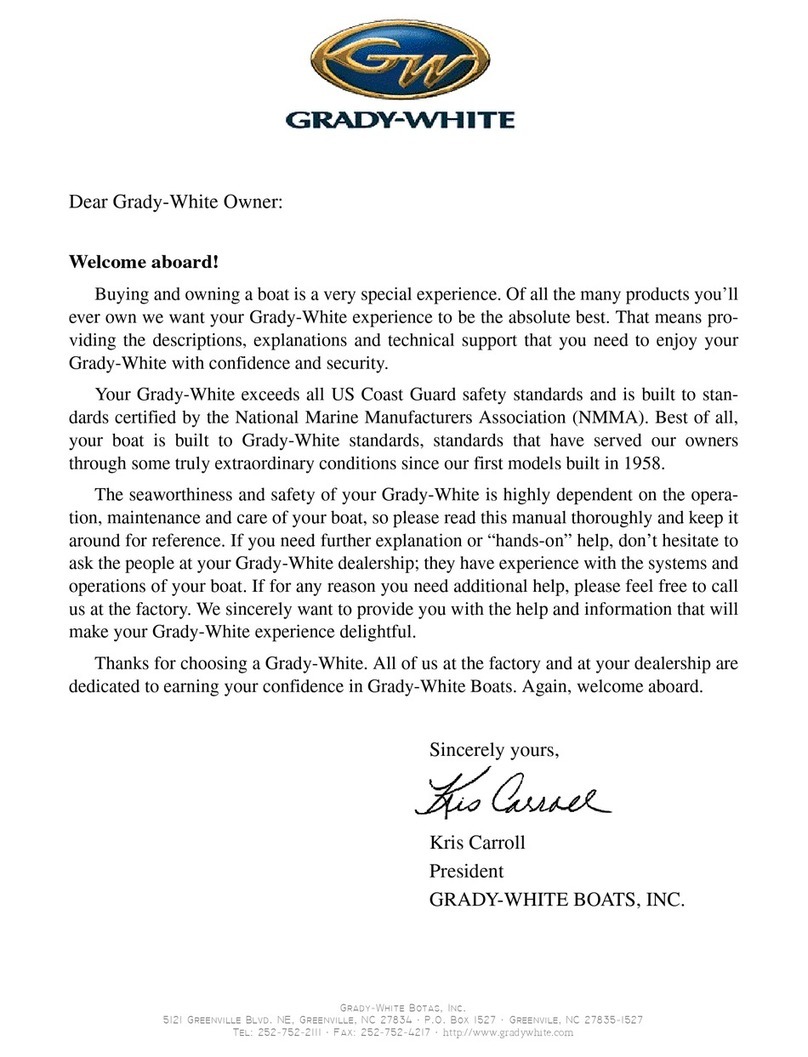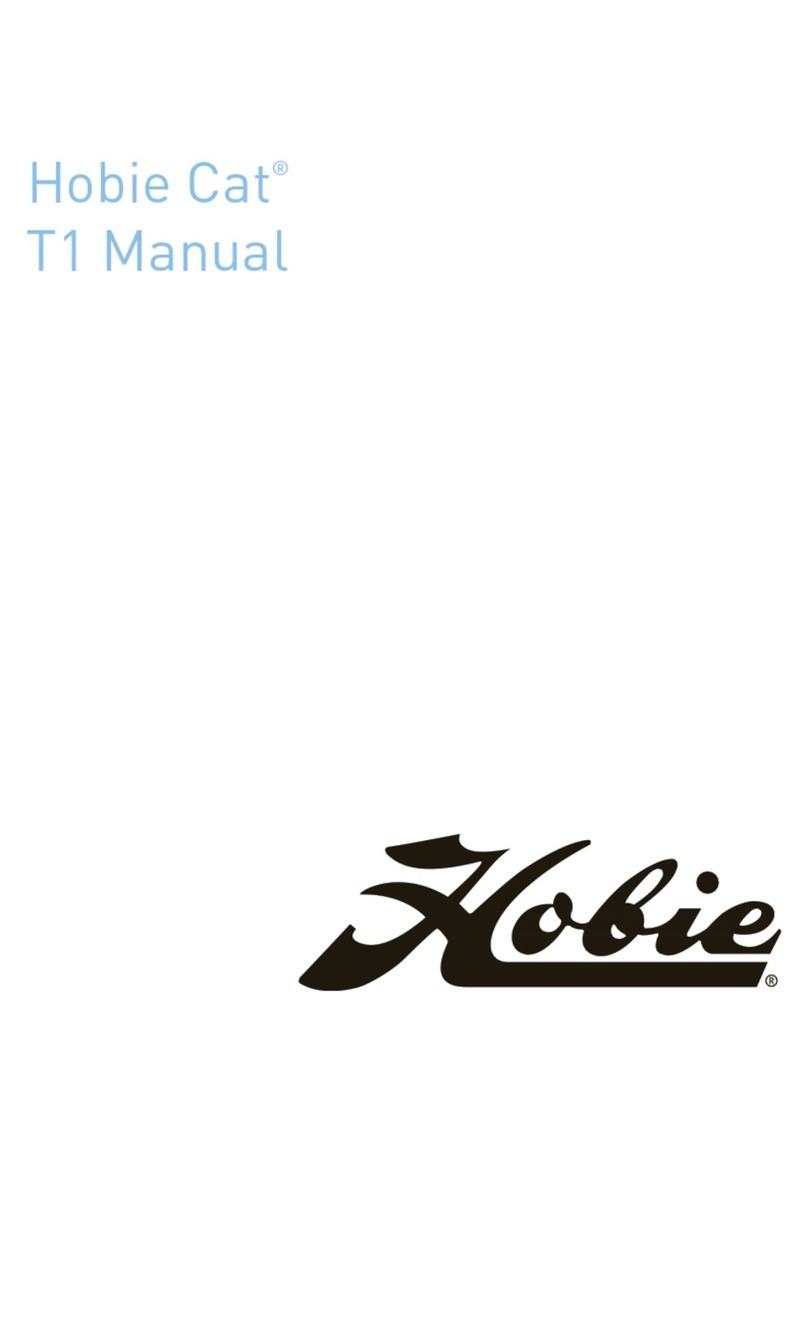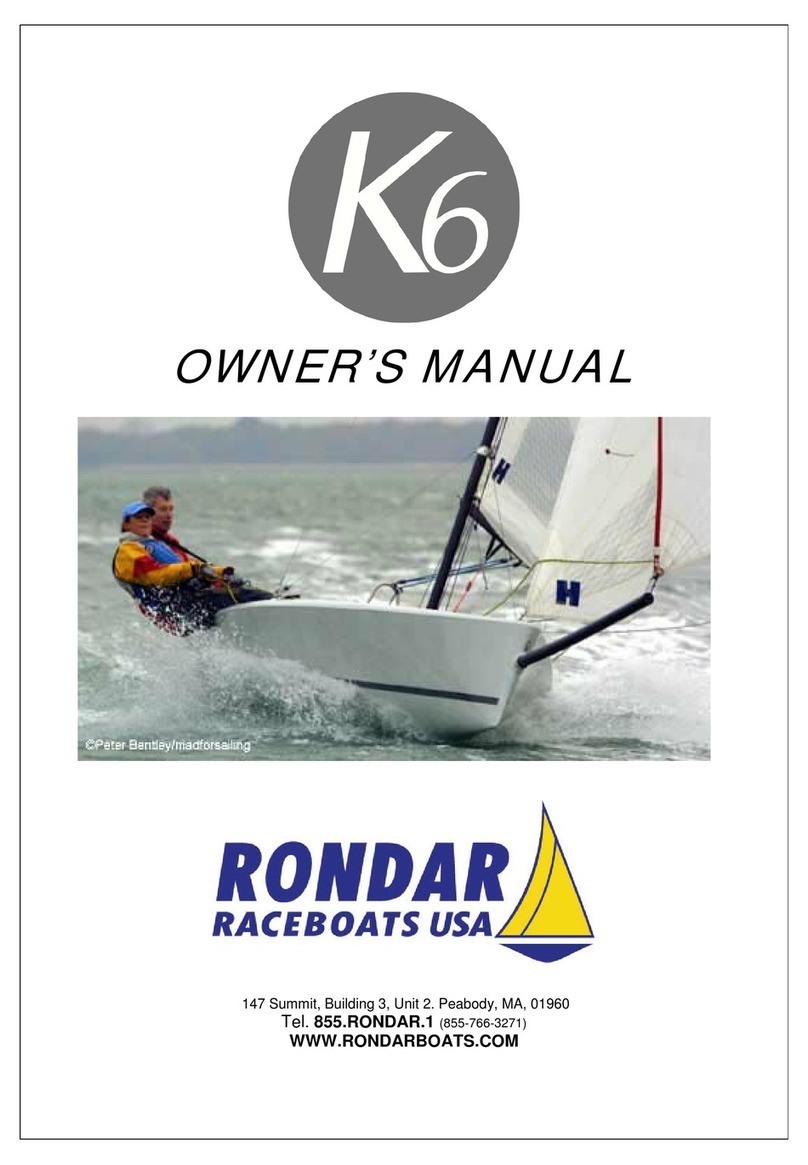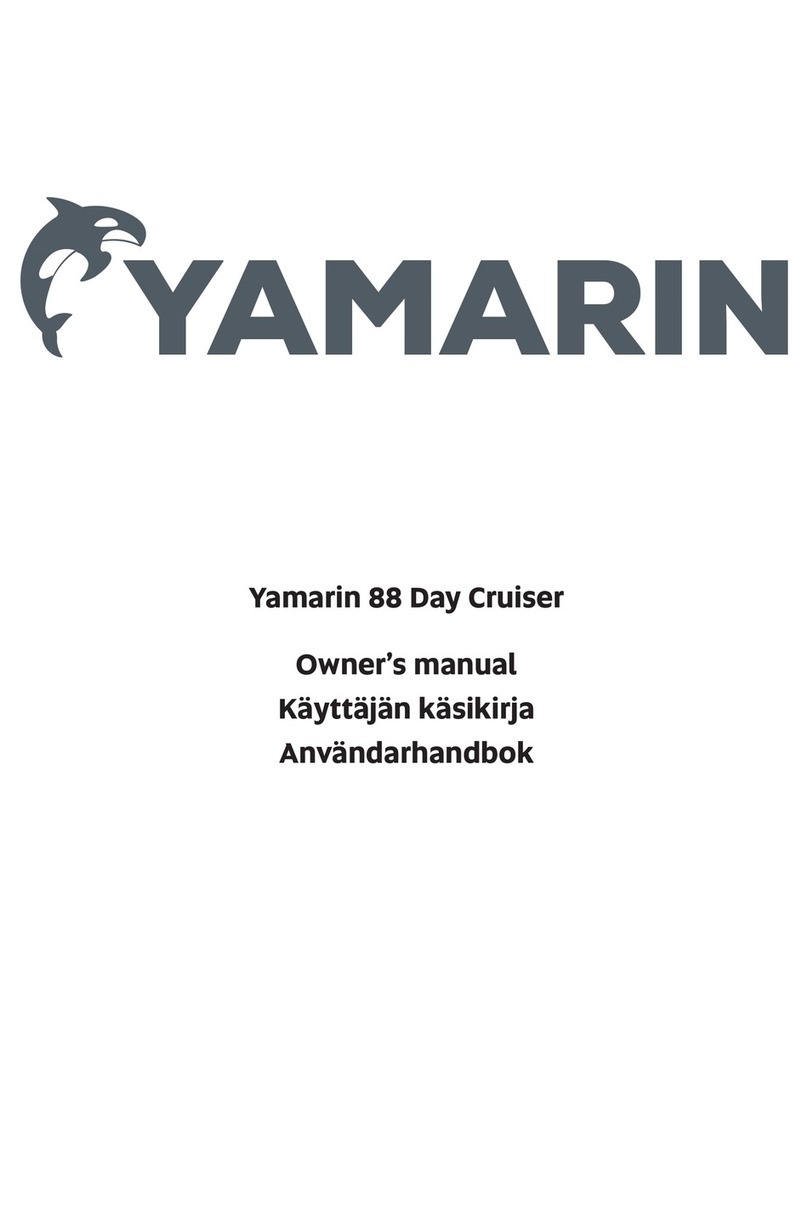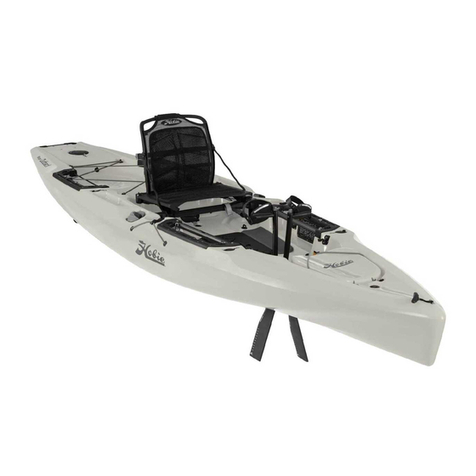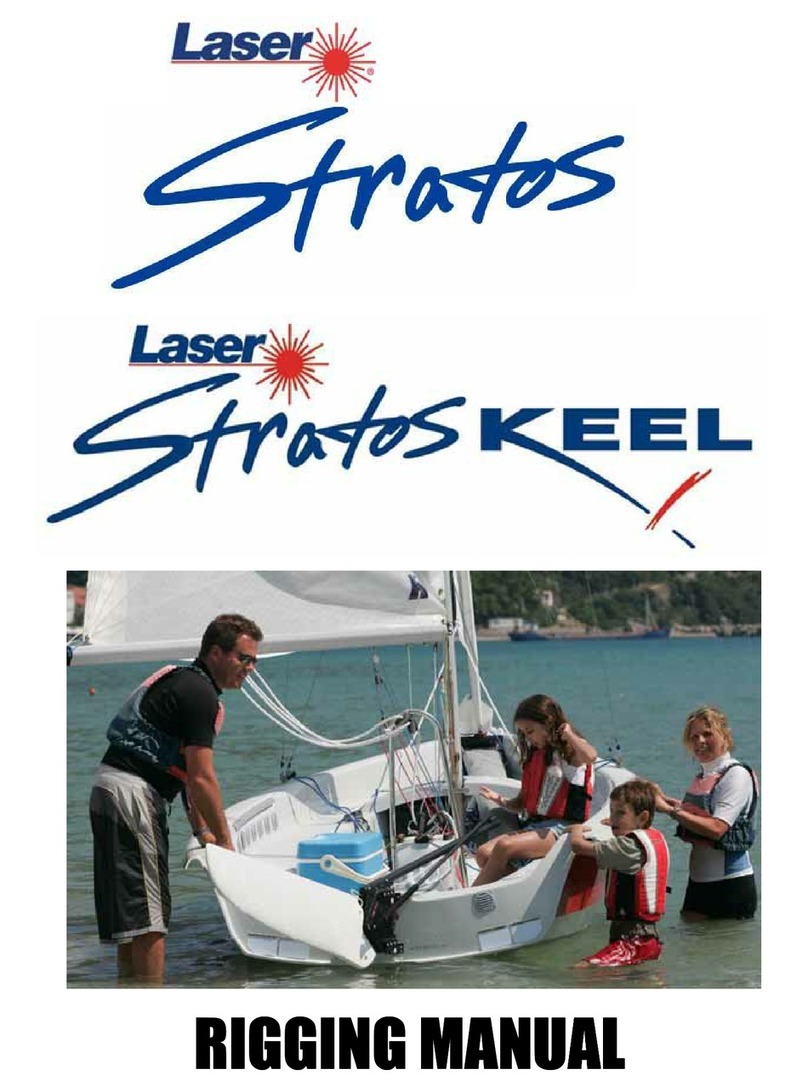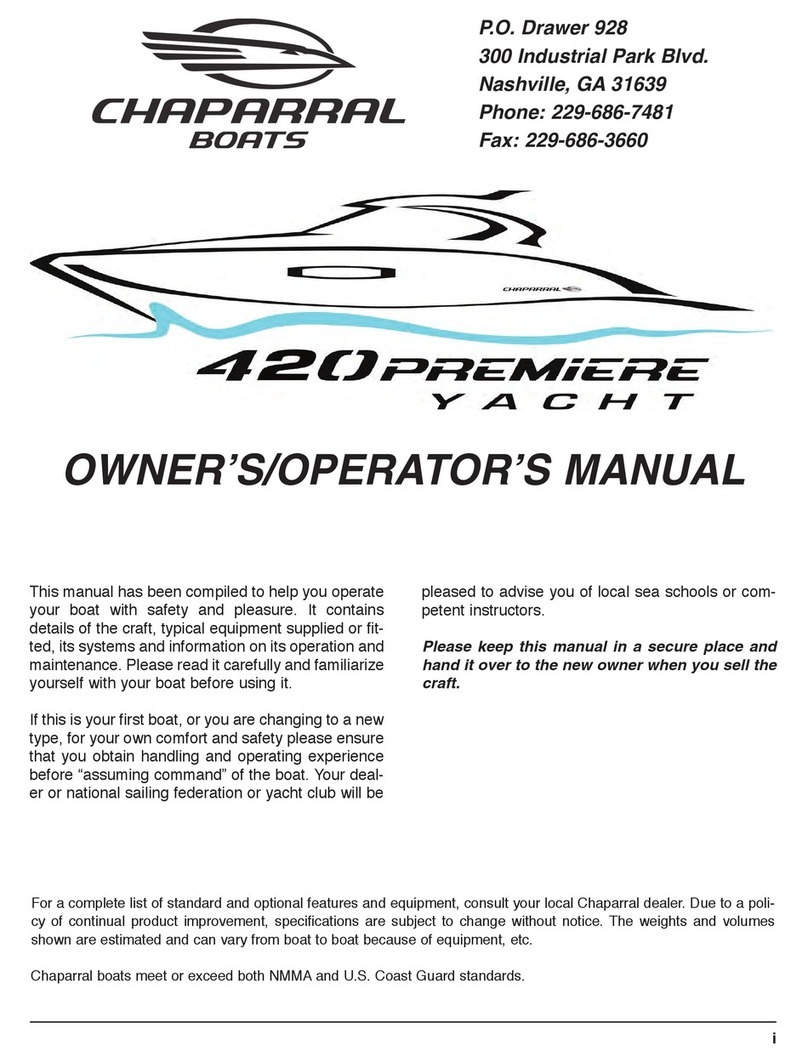SEALINE S450 User manual



:(/&20(
6HDOLQH2ZQHUV0DQXDO3DJH
Welcome to the world of Sealine, we know that you will enjoy your new craft. Before putting to sea we strongly
recommend you take time to read this manual and any other literature provided with this craft carefully and
thoroughly before use.
The Owner's Manual Packet, to be kept on board your Sealine, gives you important information on all the features
of your Sealine, for years of trouble-free boating take the time to carefully review the information in your Owner's
Manual Packet and really get to know your boat.
Have everyone who will operate this boat read this manual.
The Owner's Manual Packet contains the following:
ವOwner's Manual: The Owner's Manual gives you important operating and safety information, as well as
reminding you about your responsibilities as a boat owner/operator.
ವOriginal Equipment Manufacturer (OEM) Information: This section of your Owner's Manual Packet
contains information from the manufacturers of equipment installed on your boat. Examples include the
engine, engine control and steering system. Throughout the Owner's Manual you will be referred to
information provided by manufacturers of specific systems.
Because your purchase represents a substantial investment, we know you will want to take the necessary
measures to protect its value. We have outlined a program for proper operation, periodic maintenance and safety
inspections. We urge you to follow these recommendations. If you have questions which are not fully covered by
the Owner's Manual Packet, please consult your authorised dealer for assistance.
Thank You For Selecting A Sealine.

7$%/(2)&217(176
6HDOLQH2ZQHUV0DQXDO3DJH
INTRODUCTION
THIS MANUAL
The material here and in the rest of the Owner's
Manual Packet:
ವGives you basic safety information;
ವDescribes the features of your boat;
ವDescribes the equipment on your boat;
ವDescribes the fundamentals of boat use; and
ವContains service and maintenance information
This manual has been compiled to help you to
operate your craft with safety and pleasure. It
contains details of the craft, the equipment supplied
or fitted, its systems and information on their
operation. Please read it carefully, and familiarise
yourself with the craft before using it.
This Owner's Manual is not a course on boating
safety or seamanship. If this is your first boat, or if
you are changing to a type of boat that you are
unfamiliar with, for your own comfort and safety,
please ensure that you obtain handling and operating
experience before "assuming command" of the boat.
YOUR RESPONSIBILITIES
It is the duty of the skipper/owner to ensure that
the safety of others using the craft is met. If you
are the skipper or owner please ensure that you
have read carefully the Safety section.
For your safety, the safety of your passengers,
other boaters and people in the water, you must:
ವTake a boating safety course;
ವGet instruction in the safe and proper
handling of your boat;
ವUnderstand and follow the "COLREGs";
ವLearn how to navigate
Always maintain your craft properly and make
allowances for the deterioration that will occur in
time and as a result of heavy use or misuse of
the craft.
WARNING
Regular Inspections - Attached to this handbook
are instruction manuals for the components and
appliances fitted to your boat. Ensure you carry
out inspections regularly in accordance with
their instructions. In addition ensure you
regularly check the systems described in this
handbook.
Maintain an up to date log book and ensure that
the insurance covers you for the intended use.
Keep all relevant documents on board showing
proof of ownership in a secure place and remove
when going ashore.
This manual includes the Declaration of
Conformity to the EU Recreational Craft
Directive 2013/53/EU. This document is boat
model specific and may be required to be seen
by maritime authorities.
IMPORTANT
PLEASE KEEP THIS MANUAL IN A SECURE
PLACE, AND HAND IT OVER TO THE NEW
OWNER WHEN YOU SELL THE CRAFT.

,1752'8&7,21
6HDOLQH2ZQHUV0DQXDO3DJH
DEALER RESPONSIBILITIES
In addition to a pre-delivery check and service
of the boat, your dealer is to give you:
ವA description and demonstration of the safety
systems, features, instruments and controls on
your boat;
ವAn orientation in the general operation of your
boat;
ವA review of all warranty information and how to
obtain warranty service;
ವThe complete Owner's Manual Packet.
WARRANTIES
Your boat comes with several warranties. Each
component and/or system on your boat has its
own warranty that will be found with the
specific information and manual for that
component. These are included with your
Owner's Manual Packet. Locate and read the
individual warranties; then put them together
for easy future reference.
Always use trained and competent people for
maintenance, fixing or modifications. Modifications
that may affect the safety characteristics of the
craft shall be assessed, executed and documented
by competent people. The boat builder cannot be
held responsible for modifications that he has not
approved.
SERVICE, PARTS AND REPAIR
This owner's manual is not a detailed maintenance or
trouble-shooting guide. In the case of difficulty, refer
to the boat builder or their representative. If a
maintenance manual is provided, use it for the craft's
maintenance.
CAUTION
Contact a reputable boatyard or specialist
installation manufacturer for the best advice and
adapted parts or materials for the repairs you can
carry out by yourself. Professionals should
preferably carry out large repairs on the hull or on
the engine (see Warranty Conditions sections).
DANGER
Contact a reputable boatyard or specialist
installation manufacturer about the possibilities of
what you can do by yourself. You could endanger
your own safety and lose your warranty.
CRAFT IDENTIFICATION NUMBERS
Hull, engine and gearbox identification
The Craft Identification Number (CIN) is engraved into
the transom and is unique to your craft. Engine and
Gearbox serial numbers are also unique and can be
found on their outer casings.

6HDOLQH2ZQHUV0DQXDO3DJH

TABLE OF CONTENTS
6HDOLQH2ZQHUV0DQXDO3DJH
INTRODUCTION....................................... 4
THIS MANUAL..................................................... 4
YOUR RESPONSIBILITIES ................................ 4
DEALER RESPONSIBILITIES ............................ 5
WARRANTIES..................................................... 5
SERVICE, PARTS AND REPAIR........................ 5
CRAFT IDENTIFICATION NUMBERS ................ 5
TECHNICAL DATA & ECD..................... 10
TECHNICAL DATA............................................ 10
DECLARATION OF CONFORMITY ................... 11
RCD EXPLANATION......................................... 13
YOUR SAFETY....................................... 15
SAFETY LABELS .............................................. 16
RECOMMENDED MINIMUM EQUIPMENT ...... 17
LIFEJACKETS ................................................... 18
FIRE FIGHTING EQUIPMENT.......................... 18
AUTOMATIC EXTINGUISHING SYSTEM ........ 19
FIRE PREVENTION .......................................... 20
CARBON MONOXIDE (CO).............................. 21
IMPAIRED OPERATION ................................... 22
LOAD CAPACITY .............................................. 22
POWER CAPACITY .......................................... 22
STABILITY......................................................... 23
CHART YOUR COURSE .................................. 23
INTERNATIONAL REQUIREMENTS................ 23
MAINTAIN CONTROL ....................................... 24
WEATHER......................................................... 26
WATER SPORTS .............................................. 27
EMERGENCY SITUATIONS............................. 28
ENVIRONMENTAL CONSIDERATIONS .......... 30
ANTIFOULING................................................... 31
SOLVENTS........................................................ 31
FIRE EXTINGUISHER INFORMATION ............ 32
ACTIVE FIRE FIGHTING .................................. 33
USING YOUR BOAT .............................. 34
PREPARING TO DEPART ................................ 34
NAVIGATIONAL EQUIPMENT.......................... 35
WHILE UNDERWAY ......................................... 36
NAVIGATION AND ANCHOR LIGHTS..............37
RETURNING TO PORT .....................................38
SECURING THE BOAT .....................................38
FUELLING THE BOAT.......................................39
BOARDING ........................................................41
LIFEJACKETS....................................................41
PASSENGER INSTRUCTION & LOCATION ....41
STARTING AND STOPPING THE ENGINES ...42
STARTING THE GENERATOR .........................43
STOPPING THE GENERATOR.........................43
STEERING SYSTEMS.......................................43
ANCHORING......................................................44
WINDLASS.........................................................46
DOCKING...........................................................46
OPERATION OF SHIFT AND THROTTLE ........47
ENGINE INSTRUMENTATION ..........................47
STARTING AND STOPPING THE ENGINES ...48
MANOEUVERING WITH THE JOYSTICK.........50
TRIM SYSTEM INSTRUCTIONS.......................51
ELECTRICAL SYSTEM...........................52
DC SYSTEM.......................................................52
FUSE ASSIGNMENT POWERBOARD .............54
OVERVIEW FUSES AND BREAKERS..............55
DC PANEL..........................................................56
AC PANEL..........................................................57
AC SYSTEM.......................................................58
ENGINES & ANCILLARY EQUIPMENT .60
BILGES...............................................................60
ENGINES ...........................................................62
STEERING .........................................................63
PROPELLERS ...................................................63
CORROSION PROTECTION.............................64
ENGINE ROOM .................................................64
ENGINE EXHAUST SYSTEM............................65
BOW THRUSTER (IF FITTED) ..........................65
FUEL SYSTEM........................................66
FUEL FILTER MAINTENANCE..........................67
GAS SYSTEM .........................................68

TABLE OF CONTENTS
6HDOLQH2ZQHUV0DQXDO3DJH
WATER SYSTEM....................................71
TOILETS............................................................ 73
BOAT CARE ........................................... 74
EXTERIOR CARE ............................................. 74
INTERIOR CARE .............................................. 75
SERVICE INFORMATION....................... 76
LAYING UP AND MAINTENANCE ................... 76
DRAINING THE BOAT ...................................... 78
WINTERISING CHECK LIST ............................ 79
STORAGE AND LAUNCHING .......................... 80
REFIT AFTER STORAGE (GENERAL) ............ 81
LIFTING................................................... 82
LIFTING THE CRAFT........................................ 82
SUPPORTING THE BOAT................................ 82
DATA SHEETS & DIAGRAMS ...............84
PRINCIPAL DIMENSIONS................................ 84
DECK PLAN ...................................................... 86
SYSTEM CONTROL POINTS........................... 88
EQUIPMENT LOCATION – ACCOMMODATION
SPACE............................................................... 90
GAS SYSTEM LAYOUT.................................... 92
FIRE PROTECTION SYSTEM .......................... 94
BLACK WATER SYSTEM ................................. 96
SKIN FITTING ................................................... 98

6HDOLQH2ZQHUV0DQXDO3DJH
Information in this publication is based upon the latest product
specifications available at the time of printing.
Sealine GmbH, reserves the right to make changes at any
time, without notice, of the colours, equipment, specifications,
materials and prices of all models, or to discontinue models.
Should there be a conflict between any of the information
contained herein and that provided by the OEM then the latter
shall prevail.
Should changes in production models be made, Sealine is not
obligated to make similar changes or modifications to models
sold prior to the date of such changes.
S450 Motor Yacht Owner's Manual.
Internet www.sealine.com
Version 7.0

7(&+1,&$/'$7$
6HDOLQH2ZQHUV0DQXDO3DJH
TECHNICAL DATA & ECD
TECHNICAL DATA
Dimensions Metric Imperial to ISO 8666
Length Overall (Lmax) 13.90 m 45' 7"
Length of Hull (L
H
) 13.65 m 44' 9" LH = 13.65 m
Length at Waterline 10.85 m 35' 7"
Beam (B
H
) 4.48 m 14' 7'' BH = 4.48 m
Air Height 4.75 m 15' 7"
Hull - Draught (T
c
) 0.79 m 2' 6" T
c
= 0.79 m
Max. Draught (T
max
) 1.14 m 3' 7" T
max
= 1.14 m
Capacity Metric Imperial
Fuel Tank 2 x 600 L 2 x 132 Gal
Water Tank 1 x 315 L 1 x 69 Gal
Black Waste Tank 1 x 182 L 1 x 40 Gal
Gas Bottle 2 x 1.8 kg 2 x 4 lb
Weight Metric Imperial
Light craft mass (m
LCC
) 11.227 kg 11.05 tons
Maximum persons 12 12
Mass of the fully loaded boat (m
LDC
) 18.126 kg 17.84 tons
(Including all optional additional equipment)
Power Metric Imperial
Maximum Rated Engine Power 2 x 272 kW 2 x 370 hp
Engine Stern drive
Electrical Metric
Batteries: 12 volt DC System
Engine 2 x 95 AH
Domestic Supply 4 x 160 AH
Shore Supply Single Phase 220V AC 50 Hz

6HDOLQH2ZQHUV0DQXDO3DJH
RCD EXPLANATION
Module B+C
In accordance with the EC Directive, the certification module B+C was chosen for this yacht. The notified
body issued an EC type-examination certificate for this type, certifying that the essential requirements
were checked and have been fulfilled. The manufacturer confirms the conformity with the type.
The HPi Verification Services Ltd., located in Wallingford OX10 8BA (UK), was commissioned as a notified
body according to the EC Recreational Craft Directive (see Declaration of Conformity).
The design categories applicable are defined in the EU Recreational Craft Directive as: -
Category A
A recreational craft given design category A is considered to be designed for winds that
may exceed wind force 8 (Beaufort scale) and significant wave height of 4 m and above
but excluding abnormal conditions, such as storm, violent storm, hurricane, tornado and
extreme sea conditions or rogue waves.
Category B
A recreational craft given design category B is considered to be designed for a wind
force up to, and including, 8 and significant wave height up to, and including, 4 m.
Category C
A watercraft given design category C is considered to be designed for a wind force up
to, and including, 6 and significant wave height up to, and including, 2 m.
Category D
A watercraft given design category D is considered to be designed for a wind force up
to, and including, 4 and significant wave height up to, and including, 0,3 m, with
occasional waves of 0,5 m maximum height.
A maximum load = 6.899 Kg has been used for assessing stability and buoyancy comprising :-
Mass of Empty Craft Condition (m
EC
) 10.107 kg
Basis equipment 120 kg
Mass of Light Craft Condition (m
LC
) 11.227 kg
Factory fitted optional extras 2.500 kg
Mass of liquids in installed tanks (95%) 1.570 kg
Equipment 474 kg
Life raft 92 kg
Tender 300 kg
Stores, cargo, provisions*
)
1.063 kg
Number of persons (12 persons)*
)
900 kg
Mass of the fully loaded boat (m
LDC
) 18.126 kg
,QFOXGHGLQWKHORDGFDSDFLW\RQWKHEXLOGHUVSODWH

6HDOLQH2ZQHUV0DQXDO3DJH
EU RECREATIONAL CRAFT DIRECTIVE EXPLANATION
This boat has been given Design Category B with a crew limit of 12 in accordance with ISO 12217-1. This Category is
considered to be suitable for use in waves up to 4m significant height and a typical steady wind force of Beaufort
Force 8 or less, subject to :-
ವThe crew having suitable skill and
experience
ವSatisfactory maintenance of the boat and
equipment.
WARNING
Users of this boat are advised that:-
•all crew should receive suitable training
•the boat should not carry more than the
Maximum Persons or Load (see CE plate
description - below)
•bilge water should be kept to a minimum
•stability is reduced by any weight added high up
•in rough weather, hatches, lockers and
doorways should be closed to minimise risk of
water ingress
•stability may be reduced when towing or lifting
heavy weights using the crane
•breaking waves are a serious stability hazard,
they should reduce speed in waves and avoid
sudden manoeuvres at speed
Boat Design Category.
Maximum Person Capacity.
Manufacturer's recommended maximum
load. (excluding the mass of the
contents of fixed fuel and water tanks
when full)
All Sealine boats are being updated & improved constantly; therefore although every endeavour has been made
to ensure the accuracy of the information in this handbook, no liability can be accepted for any omissions or
discrepancies that may occur.
1
2
3

<2856$)(7<
6HDOLQH2ZQHUV0DQXDO3DJH
YOUR SAFETY
Your safety is our concern, therefore on taking
delivery of your craft, every owner or professional
skipper must understand and appreciate that:
a Competence - No skipper/owner should
commence any voyage unless they
consider themselves to have the
necessary competence and experience
to handle and navigate the craft safely,
without endangering the craft, its crew or
other vessels;
b Know your craft - A good skipper checks
the fundamentals for himself and does
not put to sea without first hand
knowledge of the craft's vital gear,
systems and their condition This is
especially relevant with a newly
commissioned craft.
c Know your crew - The skipper/owner
must take full responsibility for the
suitability, fitness and safety of the crew
(and guests) for the voyage ahead and
for the craft in its entirety.
d Safety at sea - Ensure that your guests
and crew have been informed about
safety gear and it's location before going
to sea. Check the following:
ವWeather forecast
ವDo you have sufficient life jackets;
ವIs crew conversant with the location and
launching of the life raft;
ವLocation of flares/distress equipment and
usage;
ವApart from yourself can anyone else
operate your radio equipment;
ವEnsure there is a rescue procedure for a
person overboard and that others are
aware of it;
ವDo the crew know the location of the First
Aid and fire fighting equipment? Do they
know how to use it in an emergency?
Motor sailing and being on or around boats can be
potentially dangerous. Motor yachts have many
moving parts such as passerelle cranes, windlasses
and other equipment which should only be operated
by competent crew with the utmost vigilance.
Any craft, no matter how strong it may be, can be
severely damaged if not used properly. This is not
compatible with safe boating. Always adjust the
speed and direction of the craft to sea conditions.
If this is your first craft, or you are changing to type of
craft you are not familiar with, or you have any
doubts about your competence to handle your craft.
We suggest that for the comfort and safety of you
and your crew, you gain some handling and
operating experience before assuming command.
ವGet hands-on training on how to operate
your boat properly.
In addition:
ವMaintain your boat and its safety and other
systems as recommended in this manual.
ವHave the boat inspected by a qualified
mechanic or dealer, at least annually.
ವEnsure that the Coast Guard required
safety equipment is on board and functions.

<2856$)(7<
6HDOLQH2ZQHUV0DQXDO3DJH
SAFETY LABELS
Safety precautions are given throughout this manual
and labels are mounted at key locations throughout the
boat. This safety information advises the
owner/operator and passengers of imperative safety
precautions to follow when operating and/or servicing
equipment.
See the boat specific pages at the end of this section
for the location of the safety labels on your boat.
ವDo not remove or obstruct any safety label.
ವReplace any label which becomes illegible.
ವReplacement safety labels can be obtained
by calling your dealer.
The meaning associated with each of the four basic
types of label is:
DANGER
Denotes an extreme intrinsic hazard
exists which would result in high
probability of death or irreparable injury
if proper precautions were not taken.
WARNING
Denotes a hazard exists which can result
in injury or death if proper precautions
are not taken.
CAUTION
Denotes a reminder of safety practices
or direct attention to unsafe practices
that could result in personal injury or
damage to the craft or components.
NOTICE
Information which is important to proper
operation or maintenance, but is not
hazard-related.
Audible alarms and warning lamps - Alarms and/ or
warning lamps are fitted for specific items of equipment
to warn of their operation and for any malfunction, such
as with the main engine systems, automatic bilge pumps
and if fitted, the generator and DPS.

<2856$)(7<
6HDOLQH2ZQHUV0DQXDO3DJH
RECOMMENDED MINIMUM EQUIPMENT
Sealine motor yachts are fitted with standard
equipment such as automatic and manual bilge
pump systems, fixed automatic engine room fire
extinguishers, a VHF radio telephone and basic
navigational equipment including magnetic
compass, boat speed indicator/log and depth
sounder.
It is the skipper/owners responsibility to ensure that
sufficient life saving and safety equipment is
provided for the total number of crew being carried
and to check that all safety equipment such as fire
extinguishers, distress rockets, flares and life rafts
are properly maintained, including renewing
equipment as necessary or recharging of
extinguishers at the pre-determined intervals.
The following list details the minimum safety
equipment to be carried on board at all times
However, the actual equipment you are required to
carry is laid down by the Marine Administration of
the country where you registered the craft.
a Suitable life jackets (fitted with light and
whistle for attracting attention) must be
provided for each person/child onboard. All
lifebuoys, life slings, life rafts and life jackets
should be fitted with marine grade retro-
reflective tape.
b A life aft suitable for accommodating the total
number of persons onboard, stowed on deck
as to be readily transferable to water.
If your craft is fitted with a life raft, carefully read its
operating manual. The craft should have onboard
the appropriate safety equipment (life jackets,
harness, etc) according to the type of craft, weather
conditions, etc.
c A grab bag stowed in such a way that it is
easily accessible in emergencies (the items
below may already be carried as part of this
list) and should contain:
ವLife raft sea anchor and line
ವSafety tin opener
ವWaterproof hand-held VHF
ವFirst aid kit
ವPlastic graduated drinking cup
ವ2 x light sticks or throwable floating lamps
ವDaylight signalling mirror
ವSignalling whistle
ವ2 x Red parachute flares
ವ3 x Red hand-held flares
ವNon-thirst provoking rations
ವFreshwater at the rate of 0.5L per person
ವIllustrated life-saving signals card
ವNylon string and polythene bags
ವSeasickness tablets
d An EPIRB (Emergency Position Indicating
Radio Beacon)
e Rocket parachute flares, distress rocket signals
and hand-held smoke flares as applicable for
inshore and offshore usage
f 25m (75ft) floating heaving line kept close to the
cockpit
g Suitably equipped first aid kit
h Second anchor
i Up-to date charts covering the intended cruising
waters
j Water resistant torch & set replacement
batteries)
k Engine toolkit, as recommended by OEM
VHF radio - VHF radio should only be used by
competent qualified operators. The radio needs to be
licensed and should not be used for unnecessary or
prolonged usage. Only use channel 16 for
emergencies and for the hailing of other craft.

<2856$)(7<
6HDOLQH2ZQHUV0DQXDO3DJH
LIFEJACKETS
Even strong swimmers can tire quickly in the water and
drown due to exhaustion, hypothermia, or both. The
buoyancy provided by a life jacket will allow the person
who has fallen overboard to remain afloat with far less
effort and heat loss, extending survival time necessary
to find and retrieve them, it is recommended that you
wear a life jacket or buoyancy aid unless you are sure
you don't need to.
All persons should wear a suitable life jacket when on
deck. Note that, in some countries, it is a legal
requirement to wear a buoyancy aid that complies with
their national regulations at all times.
Life jackets should be readily accessible, if not worn.
"Readily accessible" means removed from storage
bags and unbuckled. However, children and non-
swimmers should wear life jackets at all times when
aboard.
It is common sense to have everyone on board
wearing life jackets. A throwable device must also be
right at hand and ready to toss.
Test life jacket buoyancy at least once a year.
The crew should be familiar with the use of all safety
equipment and emergency manoeuvring (man
overboard recovery, towing, etc), sailing schools and
clubs regularly organize drill sessions.
The equipment is mandatory in some countries.
FIRE FIGHTING EQUIPMENT
The actual equipment you are required to carry is laid
down by the Marine Administration of the country
where you registered the craft. Local bylaws of the
country where you keep the craft may differ and may
require you to carry additional equipment.
WARNING
When replacing parts of the fire fighting
installation only use matching components, which
bear the same designation or are equivalent in
their technical and fire resistant capabilities.
IMPORTANT! - SEE BOAT SPECIFIC FIRE
SAFETY INFORMATION AT THE END OF THE
SAFETY SECTION AND IN THE FIRE
PROTECTION SYSTEM DRAWING IN THE DATA
SHEETS SECTION OF THE MANUAL.
Ensure all hatches to the engine room are closed.
WARNING
FIRE CONTAINMENT DOOR
ENGINE ROOM FIRE EXTINGUISHER SYSTEM
WILL BE COMPROMISED IF DOOR LEFT OPEN
CLOSE DOOR IMMEDIATELY AFTER USE

<2856$)(7<
6HDOLQH2ZQHUV0DQXDO3DJH
AUTOMATIC EXTINGUISHING SYSTEM
Your boat is equipped with an automatic fire
extinguisher system, located in the engine
compartment.
REFER TO THE OEM EQUIPMENT MANUAL
SUPPLIED IN THE DOCUMENT PACK.
It can also be manually set-off by means of the pull
toggle in the port wet bar.
In the event of a fire, the heat sensitive automatic
head in the engine compartment will release a fire-
extinguishing vapour, totally flooding the area.
The dashboard contains an indicator light for the
automatic fire extinguishing system. The light will be
ON when the ignition is on and indicates that the
system is ready If the light goes out while the ignition
is on, the system has discharged.
WARNING
AUTOMATIC EXTINGUISHING SYSTEM
ACTIVATING THE FIRE EXTINGUISHING
SYSTEM WILL SHUT DOWN ALL ENGINES,
GENERATORS AND POWERED ENGINE ROOM
VENTILATION.
ENSURE ALL ENGINES, GENERATORS,
POWERED ENGINE ROOM VENTILATION
HAVE BEEN SHUT DOWN.
MANUALLY SHUT DOWN GAS SYSTEMS.
EXTINGUISH ALL SMOKING MATERIALS.
DO NOT OPEN THE ENGINE
COMPARTMENT! THIS FEEDS OXYGEN TO
THE FIRE AND THE FIRE COULD RE-START.
Engine Shut Down Safety Label
In case of fire in the engine room:
In case of a fire the engine has to be stopped
immediately if the nautical safety is not reduced!
Do not open the hatches!
• Turn off the engine!
• Shut the fuel valves!
(emergency stop in front in the cockpit seats)
• Do not open the hatches!
• Activate the fire extinguishing system at the port
wet bar provided it has not automatically been
activated.
• Open the engine room only, if you are sure that
the fire is put out, the temperature has been
dropped and you are be able to fight flaring up
fire again.
DO NOT inhale fumes or vapours caused by the fire.
Wait at least fifteen (15) minutes before opening the
engine compartment. This permits the fire
extinguishing vapour to 'soak' the compartment long
enough for hot metals and fuels to cool. Have
portable extinguishers at hand and ready to use in
case the fire re-ignites.
DANGER
Fire on a yacht can turn into a nautical distress.
Try to establish radio contact (mayday or pan
pan). Keep the distress signals ready.
In case of fire in the engine room, persons not
directly involved in firefighting should leave the inside
area via the escape hatch in the forward cabin.

<2856$)(7<
6HDOLQH2ZQHUV0DQXDO3DJH
FIRE PREVENTION
A fire at sea is the most hazardous and intrinsic
danger you may ever face, therefore the following
items should be strictly followed.
WARNING
NEVER:
•obstruct passageways to exits or hatches
•obstruct safety controls, eg fuel valves,
gas valves, switches of the electrical
system
•obstruct portable fire extinguishers stowed
in lockers
•leave the craft unattended when cooking
and/or heating appliances are in use
•use gas lights in the craft
•modify any of the crafts systems
(especially electrical & fuel) or allow
unqualified personnel to modify any of the
craft's systems
•fill any fuel tank when machinery is running
or heating appliances are in use
•
smoke whilst handling fuel
WARNING
Keep the bilges clean and check for fuel vapours
at regular intervals.
WARNING
Combustible material (eg petrol) must not be
stowed in the engine space. If non-combustible
materials are stowed in the engine space they
shall be secured against falling into the
machinery and shall cause no obstruction to
access in or from the space.
WARNING
Avoid carrying petrol on board unless it is
completely necessary; reduce the risk by keeping
petrol containers, outboard motors and petrol
generators secured in the open air or in a drained
locker outside the cabin space and never use an
open container to hold or transfer petrol.
DO NOT fit free-hanging curtains or other fabrics in
the vicinity of, or above, cookers or other open-flame
devices.

<2856$)(7<
6HDOLQH2ZQHUV0DQXDO3DJH
CARBON MONOXIDE (CO)
Symptoms of carbon monoxide poisoning are
dizziness, ears ringing, headaches, nausea and
unconsciousness. A poisoning victim's skin often
turns cherry red. Because carbon monoxide gas
(CO) is odourless, colourless and tasteless, it is
unlikely to be noticed until a person is overcome.
WARNING
CARBON MONOXIDE (CO) CAN CAUSE BRAIN
DAMAGE OR DEATH.
SIGNS OF CARBON MONOXIDE POISONING
INCLUDE NAUSEA, HEADACHE, DIZZINESS,
DROWSINESS, AND LACK OF
CONSCIOUSNESS.
GET FRESH AIR IF ANYONE SHOWS SIGNS
OF CARBON MONOXIDE POISONING.
Dangerous concentrations of carbon monoxide will
be present if:
ವthe engine and/or generator exhaust systems
leak;
ವinsufficient fresh air is circulating where
people are present; and
ವfumes move from the rear of the boat into the
cockpit and cabin areas
To minimize the danger of CO accumulation when
the engine and/or generator are running, or using
burning fuel applications.
ವBe sure to have sufficient ventilation when
using canvas or window-type side curtains
when underway, anchored, moored or
docked.
ವIf the canopy is fitted, operate with the
forward hatch open and leave cabin door
open.
ವOperate all burning fuel appliances, such as
charcoal, propane, LPG, CNG or alcohol
cooking devices in areas where fresh air can
circulate. Do not use such devices where
there is no noticeable air movement,
especially in the cabin, when anchored,
moored or docked.
ವDo not idle engine without moving boat for
more than 10 minutes at a time
ವInspect the exhaust system regularly
If CO poisoning is suspected, have the victim breath
fresh air deeply. If breathing stops, resuscitate. A
victim often revives, then relapses because organs
are damaged by lack of oxygen. Seek immediate
medical attention.
WARNING
As with all styles of motor yacht DO NOT motor
your boat with the cockpit canopy side panels in
place and with the canopy aft panel stowed or
with the accommodation access door open. This
will cause the airflow around the boat's aft end to
fill the accommodation with exhaust gasses and
sea spray.
WARNING
Ventilation Grilles - It is important that engine
vents and grilles remain unobstructed. By leaving
the vents clear air can run unrestricted to the
engines ensuring efficient operation. This also
applies to all other vents/inlets/ grilles on the boat
such as those used for gas, air conditioning and
refrigeration systems which all require the
ventilation provided to operate as best possible.
Sticker located next to LPG ventilation grilles:
WARNING
DO NOT Obstruct grille as ventilation is required to
provide sufficient supply of oxygen for flame based
devices in the galley. (Where fitted.)

<2856$)(7<
6HDOLQH2ZQHUV0DQXDO3DJH
IMPAIRED OPERATION
Drugs and/or alcohol will prevent you from operating
your boat safely. This single factor is involved in
more marine accidents and deaths than any other.
The detrimental effects of alcohol and drugs are
increased by the wind, waves and sun, quickly
impairing your ability to react properly and promptly
in an emergency.
WARNING
Drugs and/or alcohol impair the operator's ability
to control the boat safely.
Death or serious injury can result from improper
boat operation.
LOAD CAPACITY
The certification plate located near the helm indicates
maximum weight and number of persons your boat
can handle.
WARNING
Do not exceed the maximum recommended
number of persons. Regardless of the number of
persons on board, the total weight of persons and
equipment must never exceed the maximum
recommended load. Always use the seats/seating
spaces provided
POWER CAPACITY
WARNING
Do not install or operate this craft with engines of
rated power larger than shown on the technical
data page.
Your Sealine has been equipped with a propeller
which our tests have shown to be the best suited for
general use with our engine under normal conditions
and load. Do not change the pitch of your propeller
without getting your dealer's recommendations first.
If you change to a different propeller pitch, under no
circumstances use a propeller which allows the
engine to operate at higher than recommended RPM
(your engine manual specifies the maximum
recommended (RPM).
To maintain rated power, propellers should be free of
nicks, excessive pitting and any distortions that alter
them from their original design. Badly damaged
propellers should be replaced, but those that are
chipped, bent or merely out of shape can be
reconditioned by your marine dealer.
It is advisable to carry spare propellers aboard in
case you damage one in use.
Table of contents
Other SEALINE Boat manuals
